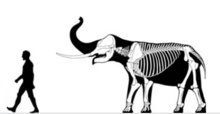
Proboscidea is a taxonomic order of afrotherian mammals containing one living family (Elephantidae) and several extinct families. First described by J. Illiger in 1811, it encompasses the elephants and their close relatives. Proboscideans include some of the largest known land mammals. The largest land mammal of all time may have been a proboscidean; the elephant Palaeoloxodon namadicus has been estimated to be up to 5.2 m (17.1 ft) at the shoulder and may have weighed up to 22 t, surpassing the paraceratheres, the otherwise largest known land mammals, though this estimate was made based on a single fragmentary femur and is speculative. The largest extant proboscidean is the African bush elephant, with a record of size of 4 m (13.1 ft) at the shoulder and 10.4 t. In addition to their enormous size, later proboscideans are distinguished by tusks and long, muscular trunks, which were less developed or absent in early proboscideans.
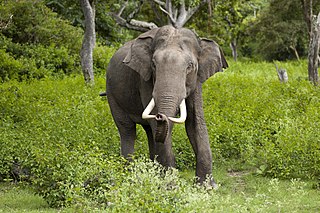
Elephantidae is a family of large, herbivorous proboscidean mammals collectively called elephants and mammoths. These are large terrestrial mammals with a snout modified into a trunk and teeth modified into tusks. Most genera and species in the family are extinct. Only two genera, Loxodonta and Elephas, are living.

Mammutidae is an extinct family of proboscideans belonging to Elephantimorpha. It is best known for the mastodons, which inhabited North America from the Late Miocene until their extinction at beginning of the Holocene, around 11,000 years ago. The earliest fossils of the group are known from the Late Oligocene of Africa, around 24 million years ago, and fossils of the group have also been found across Eurasia. The name "mastodon" derives from Greek, μαστός "nipple" and ὀδούς "tooth", referring to their characteristic teeth.

Stegodon is an extinct genus of proboscidean, related to elephants. It was originally assigned to the family Elephantidae along with modern elephants but is now placed in the extinct family Stegodontidae. Like elephants, Stegodon had teeth with plate-like lophs that are different from those of more primitive proboscideans like gomphotheres and mammutids. The oldest fossils of the genus are found in Late Miocene strata in Asia, likely originating from the more archaic Stegolophodon, shortly afterwards migrating into Africa. While the genus became extinct in Africa during the Pliocene, Stegodon remained widespread in South, Southeast and East Asia until the end of the Pleistocene.

Gomphotheres are an extinct group of proboscideans related to modern elephants. They were widespread across Afro-Eurasia and North America during the Miocene and Pliocene epochs and dispersed into South America during the Pleistocene as part of the Great American Interchange. Gomphotheres are a paraphyletic group that is ancestral to Elephantidae, which contains modern elephants, as well as Stegodontidae. While most famous forms such as Gomphotherium had long lower jaws with tusks, which is the ancestral condition for the group, some later members developed shortened (brevirostrine) lower jaws with either vestigial or no lower tusks, looking very similar to modern elephants, an example of parallel evolution, which outlasted the long-jawed gomphotheres. By the end of the Early Pleistocene, gomphotheres became extinct in Afro-Eurasia, with the last two genera, Cuvieronius ranging from southern North America to western South America, and Notiomastodon having a wide range over most of South America until the end of the Pleistocene around 12,000 years ago, when they became extinct following the arrival of humans.

Gomphotherium is an extinct genus of gomphothere proboscidean from the Neogene of Eurasia, Africa and North America. The genus is probably paraphyletic.

Anancus is an extinct genus of "tetralophodont gomphothere" native to Afro-Eurasia, that lived from the Tortonian stage of the late Miocene until its extinction during the Early Pleistocene, roughly from 8.5–2 million years ago.

Cuvieronius is an extinct New World genus of gomphothere which ranged from southern North America to western South America during the Pleistocene epoch. Among the last gomphotheres, it became extinct at the end of the Pleistocene, approximately 12,000 years ago, following the arrival of humans to the Americas.

Stegomastodon is an extinct genus of gomphotheres, a family of proboscideans. It ranged throughout North America from the early Blancan ~4 Ma, to the early Irvingtonian. The South American species have been synonymized with Notiomastodon platensis.

Mammuthus meridionalis, or the southern mammoth, is an extinct species of mammoth native to Eurasia during the Early Pleistocene, living from around 2.5 million years ago to 800,000 years ago.

Tetralophodon is an extinct genus of "tetralophodont gomphothere" belonging to the superfamily Elephantoidea, known from the Miocene of Afro-Eurasia.

Rhynchotherium is an extinct genus of proboscidea endemic to North America and Central America during the Miocene through Pliocene from 13.650 to 3.6 Ma, living for approximately 10 million years.

Eubelodon is an extinct genus of gomphothere which lived in North America during the Miocene Epoch. It contains a single species: Eubelodon morrilli.

Zygolophodon is an extinct genus of mammutid proboscidean that lived during the Miocene in Africa, Eurasia, and North America.

Notiomastodon is an extinct genus of gomphothere proboscidean, endemic to South America from the Pleistocene to the beginning of the Holocene. Notiomastodon specimens reached a size similar to that of the modern Asian elephant. Like other brevirostrine gomphotheres such as Cuvieronius and Stegomastodon, Notiomastodon had a shortened lower jaw and lacked lower tusks.
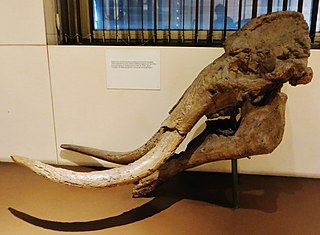
Choerolophodon is an extinct genus of proboscidean that lived during the Miocene of Eurasia and Africa. Fossils of Choerolophodon have been found in Africa, Southeast Europe, Turkey, Iraq, Iran, the Indian subcontinent, and China.
Surameryx is an extinct genus of herbivorous even-toed ungulates originally described as belonging to the extinct family Palaeomerycidae. A single species, S. acrensis, was described from the Late Miocene of the Madre de Dios Formation, South America. It was originally interpreted as one of the few northern mammals that entered South America before the Pliocene. However, both its identification as a member of the family Palaeomerycidae and claims about its Miocene age were subsequently challenged.
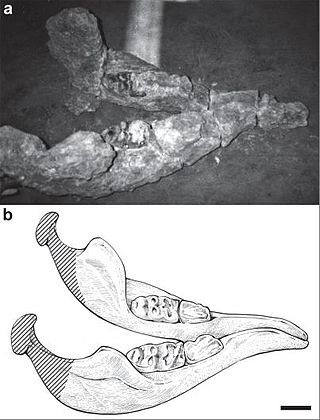
Sinomammut is a mammutid proboscidean from the Miocene of China. Only one species, S. tobieni, is known, named in 2016.
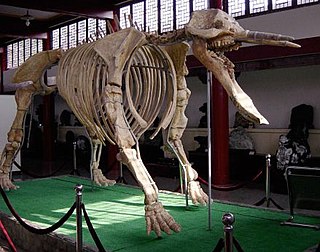
Amebelodontidae is an extinct family of large herbivorous proboscidean mammals related to elephants. They were formerly assigned to Gomphotheriidae, but recent authors consider them a distinct family. They are distinguished from other proboscideans by having flattened lower tusks and very elongate mandibular symphysis. Their molar teeth are typically trilophodont, and possessed posttrite conules. In the past, amebelodonts' shovel-like mandibular tusks led to them being portrayed scooping up water plants, however, dental microwear suggests that they were browsers and mixed feeders. The lower tusks have been proposed to have had a variety of functions depending on the species, including stripping bark, cutting through vegetation, as well as possibly digging. They first appeared in Africa during the Early Miocene, and subsequently dispersed into Eurasia and then North America. They became extinct by the beginning of the Pliocene. While some phylogenetic studies have recovered Amebelodontidae as a monophyletic group that forms the sister group to Gomphotheriidae proper, some authors have argued that Amebelodontidae may be polyphyletic, with it being suggested that the shovel-tusked condition arose several times independently within Gomphotheriidae, thus rendering the family invalid.
Eurybelodon is an extinct genus of proboscidean in the family Amebelodontidae. It lived in the Clarendonian age of the Miocene.
